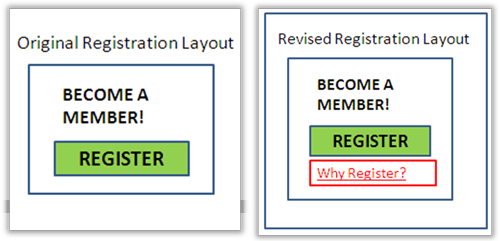Two Examples Of Conversion Optimization For B2B SEO
Search engine optimization may not always be enough. Just because a web page ranks well in organic search results, for a particular keyword, does not guarantee optimal business results. Landing pages are essential to B2B internet marketing programs. Effective landing pages drive form submissions and generate business opportunities. Unfortunately, it is not uncommon for landing […]
Search engine optimization may not always be enough. Just because a web page ranks well in organic search results, for a particular keyword, does not guarantee optimal business results.
Landing pages are essential to B2B internet marketing programs. Effective landing pages drive form submissions and generate business opportunities. Unfortunately, it is not uncommon for landing page optimization to focus more exclusively within advertising campaigns, ignoring popular channels of “free” traffic, like organic search and social media.
The chart below from Marketingsherpa supports this theory. In this survey, well under half of B2B marketers polled were receiving organic search traffic to web properties managed, were purposefully optimizing the landing experience to convert that source traffic.
We have seen this pattern with other organizations and work hard to refine focus, so conversion optimization is a component of all of our internet marketing strategies. In many cases, simple changes can improve conversion rates dramatically, and it is important to test and evaluate over time.
Here are two examples. To protect the guilty parties, page outlines have been used in lieu of screenshots, to illustrate changes in layout.
Example 1: Reducing Clicks To Conversion
The B2B solutions or products section is where the most qualified traffic should convert to lead opportunities. In the layout example below, the original solutions page adhered to a standard layout, with a link (the yellow rectangle) to an evaluation form, in the upper right-hand side of the page. While content was not an issue and we were able to drive a fair amount of keyword traffic (organic and paid search), conversion rates seemed low.
As a test, we decided to reduce the number of clicks to the form submission by placing the evaluation form directly in the right-hand margin. While this seems obvious for PPC, not everyone in the organization was sold on the recommendation at first. The results quickly changed perspectives however.
Results:
The first month we placed the evaluation form directly on the page request improved by 100% (to mid-level, double-digit lead inquiries). While we do get curiosity seekers, overall, the quality of leads have been positive. Analysis of leads generated has also uncovered a new potential target market for solution development as well.
Additional points of consideration:
- Solutions pages are usually highly visible, but make sure the proper cross-links are in place so that users and search engines can get to them often.
- Test how implementing forms directly on key conversion pages improve overall conversion rates, for both paid and organic search engine campaigns.
- Several factors can and still be tested, including the title of the form, number of form fields, and even color scheme of the “submit” button and form fields themselves.
Example 2: Explaining Why You Should Fill Out My Form
Sometimes more might actually be better. In another example, a client was having difficulty improving membership rates. While organic search engine and third party traffic was consistently on the rise, membership rates were not improving at a comparable percentage.
Visitors were finding our client’s content in search (and finding it of value given low bounce rates and reasonable time on site metrics) but were not converting as well as expected.
The change we made seemed minor but had a significant impact. As indicated in the outline below, we created a “Why Register” page and hyperlinked it immediately below the “Register” button. Potentially interested visitors had easier access to learn what the benefits might be when becoming a member.
Results:
While we cannot attribute all conversion improvements to this enhancement, conversion rates improved by nearly fifty percent in the following month, and have ranged from fifty to upwards of two hundred percent year over year improvement since.
Additional points of consideration:
- We also added the “Why Register” link above the form submission as well, as additional reassurance in the process.
- Don’t forget the call to action on the supporting page (in this case, a link to membership registration). It seems obvious but sometimes this will be overlooked in the rush to get content implemented.
Final Thoughts
To truly unlock the value of a search engine optimization strategy, B2B SEO’s should always consider how web pages sending organic search traffic can attain better conversion rates. Sometimes simple changes can lead to dramatic improvements and it is critical to continually test and refine strategies.
What has worked in your B2B SEO implementations? I would love to read your thoughts and perspective via comments below.
Contributing authors are invited to create content for Search Engine Land and are chosen for their expertise and contribution to the search community. Our contributors work under the oversight of the editorial staff and contributions are checked for quality and relevance to our readers. The opinions they express are their own.
Related stories
New on Search Engine Land


